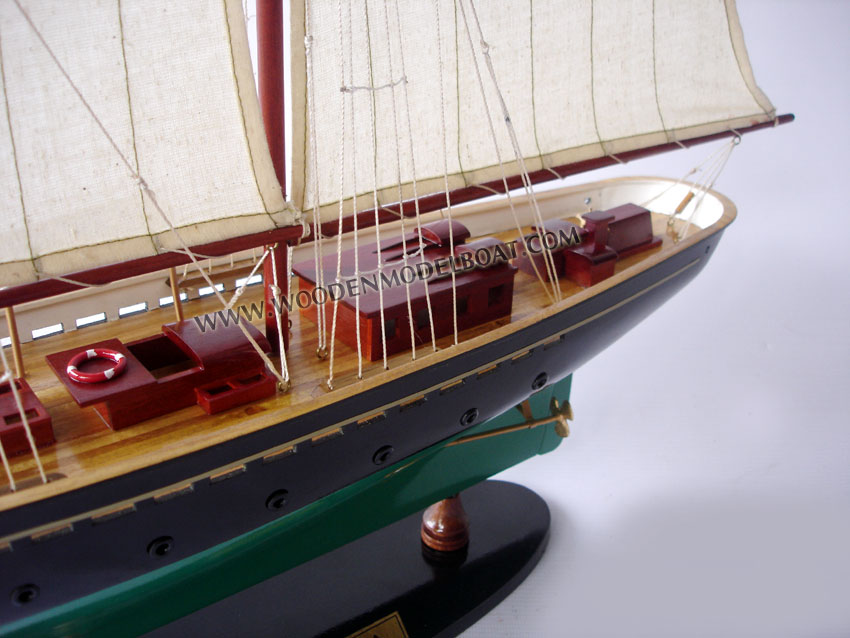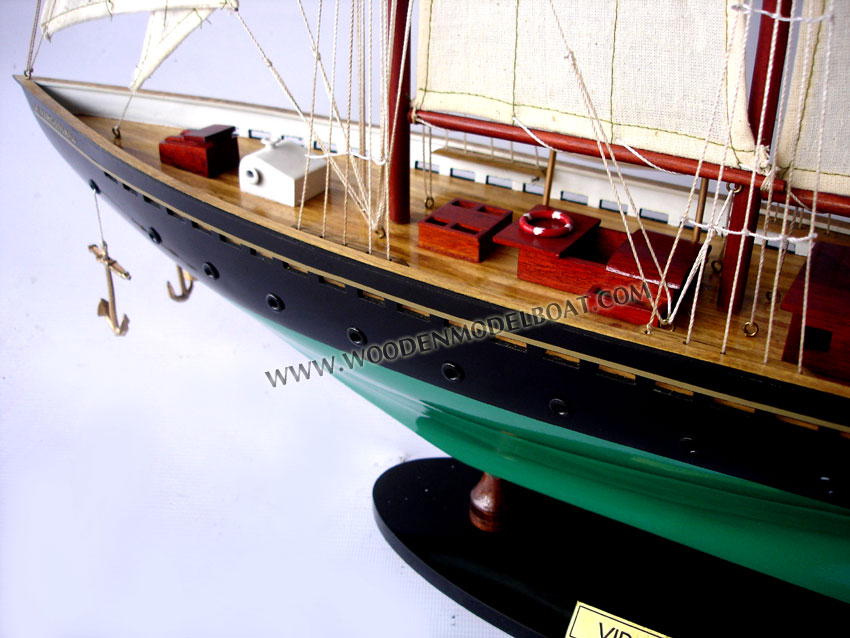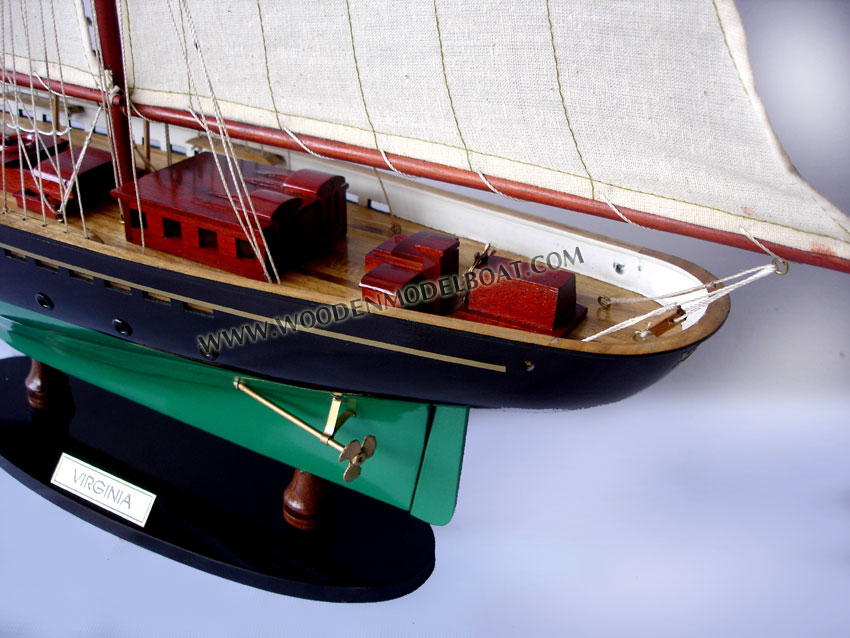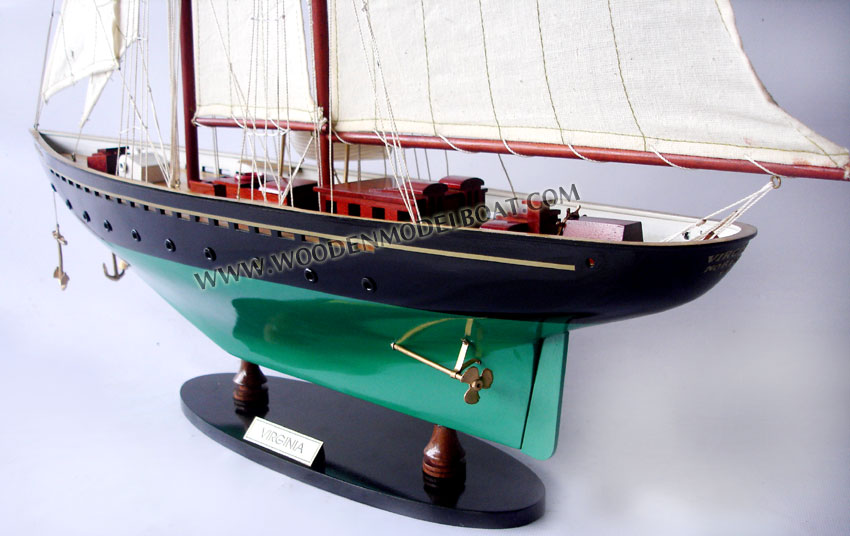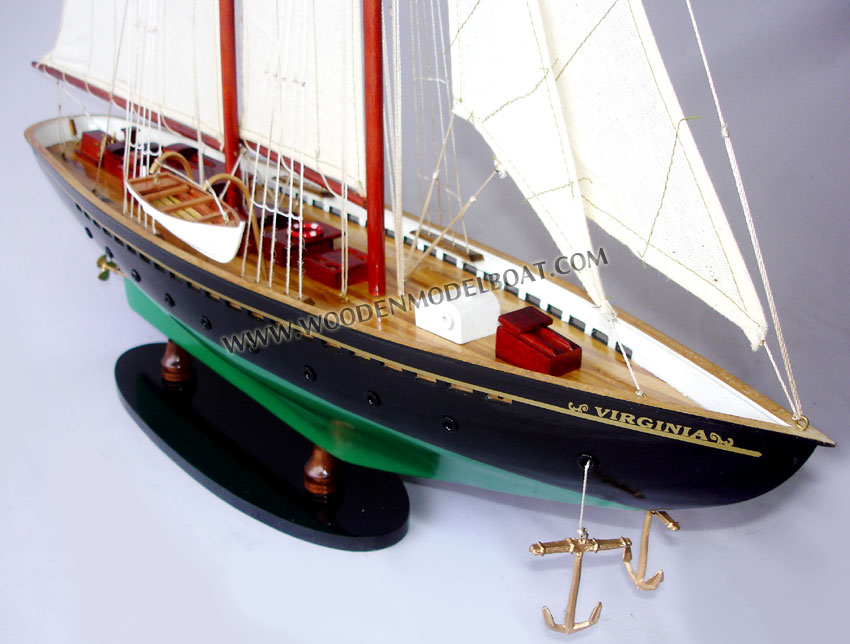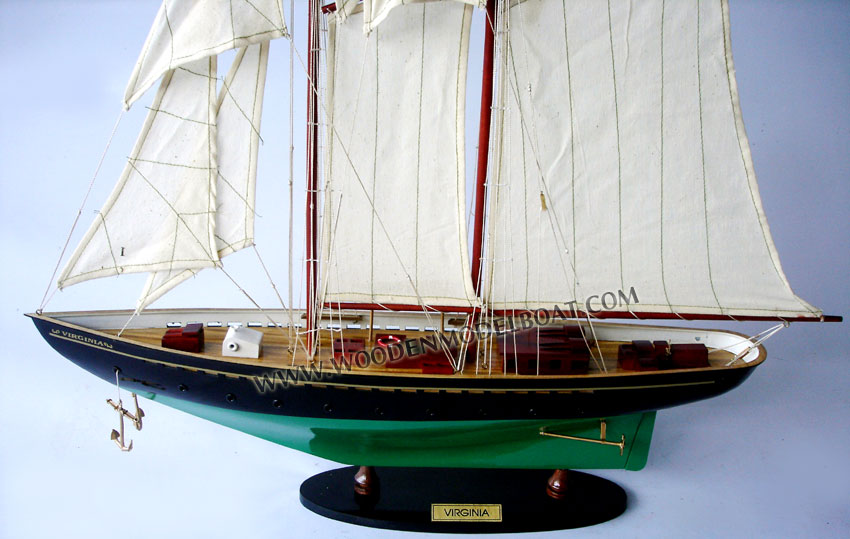The original pilot schooner Virginia was
the 5th ocean-keeping vessel owned by the Virginia
Pilot Association. She was also the 4th wooden
schooner, and the 3rd and last pilot ship built
expressly for the pilots.
Although the Virginia pilots had
entered the age of steam power with the coal-fired
steam pilot cutter RELIEF some 25 years before,
pilot President William Rowe Boutwell caused the
schooner Virginia to
be built in order "to keep the pilots sharp sailors"
and to train apprentices.
World War I had begun in Europe
when Boutwell contracted with Marine Architects, Cox
and Stevens, to design the pilot ship "along the
lines of an America's cup defender". The plans,
drawn on silk in the fashion of the day, were sent
to shipwrights A.C. Brown & Son, Tottenville, Staten
Island, New York. They completed her in late 1916.
After sea trials and shake down cruises, several
Virginia pilots entrained for New York to sail home
their new engine-less ship.
Her first duties were to remain
in Hampton Roads inside the anti-sub nets and
transfer pilots on and off ships moving into and out
of the anchorages. They used sail and the tidal
currents to maneuver near enough to a ship to send a
rowing boat to transfer the pilot. Having no davits
at the time, she towed her yawl or fished it aboard,
using a line such as a gantline (working halyard).
In the closing years of WWI,
with American troops fighting in France, convoys
were moving steadily through the Capes. At that
time, for some undiscovered reason, both Maryland
and Virginia steam pilot cutters had to go into
Norfolk harbor at the same time. Pilot Schooner Virginia was
left to board all ships in Maryland and Virginia
convoys, while under sail, transferring pilots with
rowing yawls. She did this for the better part of
two days and nights before being relieved by the two
steamers. Virginia left the pilot station
at Cape Henry for Hampton Roads, passing Old Point
Comfort, 15.3 miles away in one hour, flat.
Virginia's food and
water supply were depleted by the extra service she
had just rendered, so she continued to her berth in
Norfolk on the Eastern Branch of the Elizabeth
River. Once made fast in the slip, the vessel was
loaded with the normal supply of food, water, and
other amenities needed. All she had to do now was
to wait for a favorable breeze.
There were two Virginia's
in Hampton Roads during that era. The other was a
small, rather fleet ferry, the C&O Virginia, a.k.a.
"SMOKEY JOE" to the locals. She shuttled passengers
between the Chesapeake & Ohio (C&O) rail terminals
at Norfolk and Newport News, Virginia. She made that
run two or three times daily, quickly and timely.
Pilot Schooner Virginia awoke
to find the wind just right for getting underway.
Pilot "Scobie" Guy was the ship's skipper for that
month. Once they cleared the berth, Scobie tacked Virginia down
river, past the spot where her new descendant is
being constructed, as the Berkley Bridge slowly
raised its cumbersome two sides. By then,Virginia was
heeled down to where her 108 foot tall mainmast
would not clear the roadway. At just the right
moment, Scobie had his crew to slack sheets. The
boat stood up, shot through the opened bridge,
filled again, and romped away.
At about the same time, "Smokey
Joe" had left her Brook Avenue berth, with
passengers aboard, bound for Newport News. Out in
the river, just below Hospital Point, steam and sail
began taking each other's measure. "Smokey Joe"
could really move, and as her Skipper smiled and
called for a few more engine turns, Scobie shook out
a bit more canvas.
Racing northward up the buoyed
channel, the Steamer could not shake off the
Schooner. "Smokey Joe," drawing five feet less
water than the Virginia's
15 feet, always took the ferry channel through the
anchorage to Newport News, and today was no
exception. Scobie knew that the fairway was too
shallow for the schooner and carried on another
1,000 yards or so before turning off the wind.
With wind abaft, the sleek
schooner tore along after her slippery steam sister.
She converged on "Smokey Joe's" wake and crossed
her stern as the steamer slowed for her berth.
Cheers went up from each vessel for a "well done".
After WW I had ended, good
sailors became more costly. In 1919, a pair of 75
h.p. diesel engines were installed, with an awfully
ugly, tall "smoke stack" right forward of the
mainmast that necessitated shortening the fore boom.
She carried her yawl boats in new davits. The surf
boat, which transferred pilots, crew, blocks of ice,
mail in canvas bags, food stores, engine parts, and
most anything else, remained stationed ashore at
Cape Henry. Boat Keeper O'Keefe responded to
signals and, surf permitting, rowed off the beach to
the cutter.
In the 1920's, the local press
began taking Virginia to
task for entertaining and partying more than the
press thought she should. Frankly, the pilots WERE
politicking, forced to defend the Association from
political attacks from an ambitious Governor
Westmoreland Davis, running for re-election and
using the pilots as a political football. One such
party was aboard Virginia on
a bright summer's day. They were at anchor near
Hampton Bar. A glance at a chart will show that the
bar is nearly vertical with four feet of hard sand
on it. An afternoon thunderstorm pounced, as our
local squalls will. Virginia slacked
out her spare anchor, but continued dragging both
anchors backward toward the bar. Besides being
lofty, she now had that ugly stack in the wind,
giving her a bad habit of not staying put in any
strong breeze. In desperation, the crew dove below,
unshipped the cast-iron cook stove, struggled
top-side with it, and bent a hawser to it. They
dropped this "3rd anchor" off the bow and the
schooner checked up smartly. The squall passed
quickly. The 3 "anchors" were retrieved as she
sailed off the anchor to deposit her guests safely
ashore.
Months later, her "bad habit"
showed up once again. [From an interview with Capt.
A.C. Johnson, Sr. 1898-1997]
"Well, we were anchored in the
main anchorage, a bit East of Middle Ground
(Lighthouse). During the night, a strong
Westerly came up slowly, catching most of us asleep.
The watch called us out, hollering that we were
dragging backwards towards the Virginia Railroad
coal piers. She went across the anchorage, across
Norfolk channel. Even after we got our second
anchor over, she still slipped in between the two
piers. That main boom you're talking about, it went
into a window of a coal barge lying there. The
Barge Captain's woman, about 300 pounds, came on
deck and layed a cussin' on us like we had never
heard before. You can be sure we left in a hurry."
In 1939, a Mr. Walter K. Queen
bought Virginia,
registered her in Boston, but due to her 118 foot
length, probably kept her at a berth in Marblehead.
She stayed there throughout WW II and was sold in
1944. It is here that her wake trails away. More
historical research or luck may possibly tell us the
rest of the story of Schooner Virginia.




